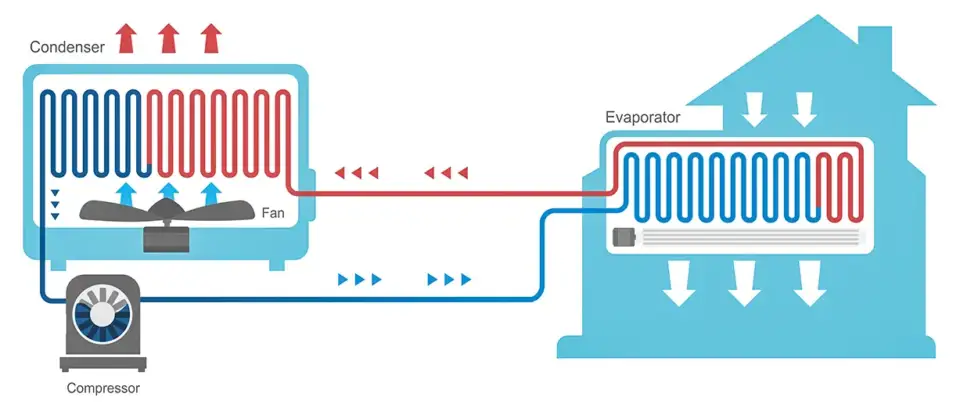The air conditioner is one of the most vital components in our homes. Most of us could hardly live without it. But for such an essential piece of equipment, most people do not understand how it works.
Today at Blankenship Heat & Air, we wanted to take a moment to shed some light on the inner workings of your heating and cooling system. A little knowledge about how your HVAC operates might save you some dollars here and there and maybe even prevent a service call.
What Exactly Is an HVAC System?
The acronym HVAC stands for Heating, Ventilation, and Air Conditioning. Although an HVAC system consists of several pieces of complex machinery, when you boil it down, it’s simply your home’s climate controller.
There are different types of HVAC systems, from heat pumps to ductless systems to central heating and air. Regardless of the type of HVAC your home uses, it operates on a fundamental scientific principle known as Charles’s Law.
Charles’s Law states that a gas’s temperature varies in direct proportion to its pressure. In layman’s terms, by manipulating the pressure of the refrigerant in your system, your HVAC can either warm up or cool down your living space.
How Does This System Work?
The lifeblood of your HVAC system is called refrigerant, and it travels in an endless loop between your outside and inside units. Along the way, the pressure of the refrigerant is manipulated to take advantage of Charles’s Law.
Initially, the outdoor unit compresses the refrigerant, causing its temperature to rise significantly. This heated refrigerant then cools down and turns into a liquid as it moves indoors. Upon entering your home, it expands back into a gas. This process drastically reduces its temperature, thereby cooling your home. Subsequently, this cold refrigerant absorbs heat from the indoor air and transports it outside, completing the cycle.
Key Components of Your HVAC System
Diving deeper, let’s break down the anatomy of a typical HVAC system into its core components:
- Outdoor Unit (Condenser): This part of your HVAC system lives outside your home, often in the backyard or on the side of the building. It houses the compressor, condenser coil, and condenser fan. The compressor is the heart of your system, pumping refrigerant throughout. The condenser coil removes heat from the refrigerant, and the fan expels it outside.
- Indoor Unit: The other half of the system is located inside your home, typically in the attic or a dedicated closet. Here, the evaporator coil and blower live. The evaporator coil absorbs heat from indoor air, doing the opposite job of the condenser coil. The blower, meanwhile, circulates air over the evaporator coil to cool it.
- Refrigerant-Filled Tubing (Line Set): Connecting the indoor and outdoor units, this tubing is the conduit for the refrigerant. This substance carries heat in and out of your home.
We don’t expect our customers to be experts at HVAC components. But, having a basic understanding can help you communicate effectively with technicians and make informed decisions about maintenance and upgrades.
The Cooling and Heating Cycle

- Compression: The cycle begins with the compressor pressuring the refrigerant, raising its temperature significantly. Think of it as preparing the refrigerant for its journey by giving it a thermal boost.
- Condensation: Once pressurized and heated, the refrigerant moves to the condenser coil. Here, the hot refrigerant releases its accumulated heat to the outside air, facilitated by the condenser fan. As it loses heat, the refrigerant condenses into a liquid form, ready for the next step in the cycle.
- Expansion and Evaporation: The liquid refrigerant travels indoors through the refrigerant line to the evaporator coil. As it enters, it passes through an expansion valve, which reduces its pressure, causing it to cool rapidly and revert to a gaseous state. In this cold state, the refrigerant absorbs heat from the indoor air passing over the evaporator coil, cooling it in the process.
- Heat Absorption and Air Circulation: The now-warm refrigerant absorbs heat from the indoor air and returns to the outdoor unit to begin the cycle anew. Meanwhile, the blower circulates the cooled air throughout your home, providing the comfort we associate with air conditioning.
This cycle of compression, condensation, expansion, and evaporation is the core of the cooling process in HVAC systems.
Final Thoughts
Understanding the ins and outs of your HVAC system is more than an exercise of curiosity. By familiarizing yourself with how your system works, you’re better equipped to recognize signs of trouble, perform basic maintenance, and communicate effectively with professionals when the time comes for service or upgrades.
But knowledge alone isn’t enough; regular maintenance is the key to unlocking your HVAC system’s full potential. Just as we rely on our HVAC systems to maintain our comfort, they depend on us to maintain their efficiency and longevity. Regular checks, filter changes, and professional inspections can prevent most HVAC issues before they become problems, saving time, money, and discomfort in the process.
After all, your comfort isn’t just a luxury; it’s a necessity. And, remember that your friends at Blankenship HVAC are always a phone call away when you need help with your AC. Call us any time at (731) 733-3333!




